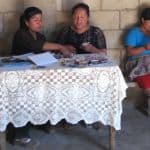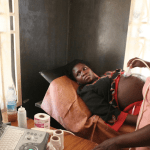From Grameen Bank to Global Scale: The New Edition of a Classic Book Highlights the Hard Truth – And Enduring Value – Behind Microfinance
In 1996, Alex Counts published “Small Loans, Big Dreams,” an account of the origins and growth of Grameen Bank. The book explored the work of Grameen Bank founder Muhammad Yunus to provide microloans to women entrepreneurs in Bangladesh — and an early effort to bring the microfinance model to America by supporting women-owned businesses in Chicago.
A year after the book’s publication, Counts would launch Grameen Foundation, which he built into a prominent global humanitarian organization before stepping down from his leadership role in 2015. Since then, he has remained active in the financial inclusion sector, participating in a number of advisory councils and working groups, while sharing insights on microfinance and mission-focused leadership via multiple books and articles.
Counts has just come out with a new edition of “Small Loans, Big Dreams, offering reflections on the ongoing evolution of Grameen Bank and the broader microfinance sector, and responding to critics who have questioned the value of the Grameen model and the industry’s role in international development.
Why read a book that was first written nearly 30 years ago — and what do these new updates tell us about the current state of the global microfinance sector? Since 1996, microfinance has grown, matured — and largely disappeared from the global development dialogue. Despite the shift in global attention, many microfinance institutions have succeeded so well that they are now an essential part of the financial sector in the countries where they operate, no longer requiring the assistance of international development organizations and grant-makers. Meanwhile, both the industry and individual microfinance providers like Grameen Bank have evolved to respond to challenges ranging from economic downturns to environmental crises, while exploring new variations on the microfinance model.
In the updated book, Counts explores these changes, while grounding readers in the early history of microfinance. If you are new to the story, you’ll learn how Yunus launched and grew the Grameen Bank from a tiny experiment into a bank serving millions of poor women. The insight, positioning, ingenuity and perseverance that enabled him to build the bank and influence the growth of microfinance across the world can provide inspiration for generations of young social entrepreneurs.
Yunus’ experiment began shortly after Bangladesh gained independence, when prospects for the country looked bleak. This was also when BRAC was founded by another inspiring Bangladeshi leader, Sir Fazle Hasan Abed, the subject of a recently published biography, “Hope over Fate,” by Scott Macmillan. Grameen Bank and BRAC had in common a deep commitment to the very poor, especially women. The sheer competence of these institutions over decades has allowed them to grow and contribute mightily to Bangladesh’s gains in poverty alleviation, in contrast to the often abjectly ineffective efforts of the government. Both organizations have also built and influenced other development organizations all over the world. It would be interesting to examine the factors in the environment that allowed two such exceptional leaders and organizations to emerge and flourish in Bangladesh, but I will leave that for another day and simply say, if you don’t know the Grameen Bank story, read this book.
For those who, like me, have long known the origins of Grameen Bank, the appeal of this book is in the people it profiles. It allows those of us who are inspired to work on behalf of the poor to spend time with poor people, even if only in the pages of a book. It takes the reader deeply into the lives of very poor self-employed women who are Grameen Bank customers — and members of the Women’s Self-Employment Project, a microfinance organization that adapted the Grameen Bank model to serve low-income women entrepreneurs on Chicago’s south side. Counts spent months as a quiet observer while these women carried out transactions and solved problems in their lending groups. He shares the experiences of Queenesta and Thelma in Chicago, and Amodini and Amena in Bangladesh, among others, presenting them to us in a way that brings these individuals to life. We come to care about them, and that makes the book a pleasure to read. The American women use their microloans to sell inexpensive merchandise in street markets, while the Bangladeshis raise poultry and livestock and conduct many other economic activities. Their lives are hard, filled with both successes and setbacks, and we follow them through the accompanying emotional ups and downs.
Reading about how these women pursued self-employment, I found myself re-asking fundamental questions about Professor Yunus’ philosophy — and indeed, about microfinance itself. Is self-employment really the path out of poverty? And if so, how do microloans help? The first question nearly answers itself: For the women borrowers Grameen Bank was serving, self-employment was the only available path. Employment opportunities were scarce, or precluded by family responsibilities and other challenges. Even in 2022, this remains a reality in much of the world. When microfinance supports self-employment, it acknowledges that reality and meets people where they are.
The second question, on how microfinance helps, is the subject of exhaustive (and sometimes exhausting) research. Instead of rehashing the debates around these findings, Counts offers a first-hand narrative that deeply enhances readers’ understanding of microfinance’s multifaceted impact, even if it does not provide statistical proof.
For the borrowers profiled here, a microloan begins with elation: They have money in hand, and suddenly, everything they want to buy is within reach. This is followed by weeks or months of struggle, as repayments fall due with appalling regularity. The Bangladeshi and U.S. borrowers in this book used their loans to acquire productive assets — inventory, a few ducks, a cow, or a fraction of an acre of land. These assets were particularly valuable when purchases of land, raw materials or tools allowed these women to reap more value from the work they were already doing, rather than losing it to landlords or middlemen. Such was the case for the stool-weavers Yunus first lent to. As piece-rate workers, middlemen controlled the market and paid the weavers a pittance for their labor. Loan capital allowed the weavers to buy their own raw materials and sell their product in the open market.
Although microloans offer borrowers a potentially more profitable solution than low-wage labor, betting on an expensive asset can be a big risk. The women in both countries experienced theft, flood, betrayal, illness, competition, and business experiments that just didn’t work. In Counts’ retelling, they persevered, and many of them gradually gained stability.
Grameen Bank’s lending model requires borrowers to form groups, whose members support each other in generating savings and repaying loans. Often, it was the support of the group that led the bank’s customers forward, as they provided each other with emotional support, business tips and patience with slow repayment. Today, as microfinance has moved to largely individual lending, group solidarity is not an integral part of the model, which may represent a profound loss.
Counts presents these women — and the microfinance sector’s hard reality — without sentimentality. The poorest people live in a world of risks, which are magnified when they add the obligation to repay a loan. Many of the women in this book gained greater independence and economic security when access to capital boosted their self-employment activities, and they better weathered shocks through group support. But clearly not every microfinance borrower will experience the same benefits or business success, and some will find that their loans actually make their circumstances worse.
The plain truth is that credit is a powerful sword, sharp on both sides. Loans equip the self-employed to get into the battle, but do not guarantee that they will win. Can poor women bear the risks involved when they receive a loan? The women profiled in “Small Loans, Big Dreams” show that they can. And as Yunus and Counts assert, the poor can and should be agents of their own development. Perhaps that is the ultimate lesson Counts’ book provides about microfinance’s evolution — and its longevity: The pathway out of poverty may be a risky one, but the poor have a right to choose it.
Elisabeth Rhyne is an independent consultant working mainly on financial health and consumer protection.
Photo courtesy of Kris Robinson.
- Categories
- Finance



